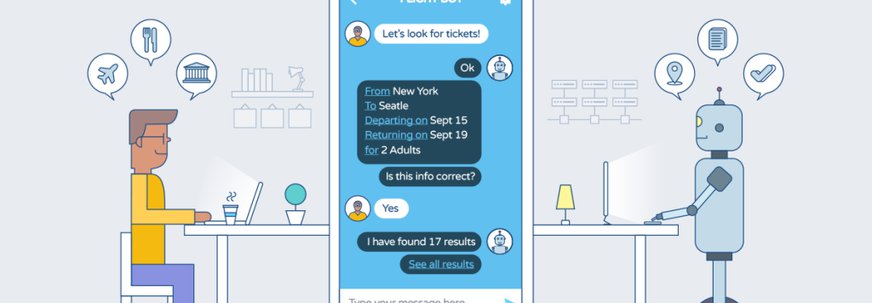Chatbot app development is making companies remove manpower deployed for redundant tasks and utilize them for more complicated tasks that actually matter.
If you have an Alexa, interacted with Google Assistant or got in touch with a customer service executive on an app, you have already spoken to a chatbot. Today’s tech advancements push the limits of chatbot app development to great extents.
That’s why some of them are also on the verge of cracking the Turing Test. From a business perspective, chatbots are inevitable and are value additions to your company’s operations.
How?
That’s because they can cut down your customer services expenses by 30%. From a customer perspective, they are ideal for the handling of some of the most redundant tasks. Around 40% of the millennials today interact with a chatbot every day. Not just that. Close to 69% of consumers prefer chatbots over company’s official apps.
Officially, chatbots have become part of our lives and if you’re a business owner, you need to understand that the sooner you implement chatbots in your operations, the more profits and productivity.
But this might sound a little daunting and there’s absolutely no need to worry. We’ve got you covered with this special write up on ai chatbot development for your business. In this extensive guide, we will guide you on how to implement voice bot development seamlessly and understand the purpose of your implementation.
So, let’s get started from the basics.
What is a Chatbot?
Though chatbots appear to be futuristic and savvy, the first chatbot was developed and rolled out in the year 1966. It was a time even before the onset of the internet.
Intriguing right?
However, the tech advancements of today such as Big Data, analytics, artificial intelligence, machine learning, cloud computing and more have extensively propelled the commercial implementation of chatbots.
For those of you who didn’t know, chatbots are artificially intelligent robots that are capable of mimicking human behavior in terms of conversations. They are powered by two technologies – artificial intelligence and natural language processing – and learn from the conversations they have with humans. As time passes, they become experts at responding to queries and questions and offer responses that are almost human-like.
Because of these super-resourceful functionalities, companies across retail, finance, banking, healthcare and other sectors are deploying chatbots to interact with consumers.
How Do They Function?
Chatbots function similar to humans. They are made of complex machine learning algorithms that constantly learn from interactions. These algorithms process incoming questions and pick the most ideal and appropriate response from their pools and present it to consumers or users. For this to happen, natural language processing has to be deployed first for the bots to understand what a human is saying. Once the data is assimilated, the artificial intelligence aspect kickstarts the response function and throws the output in the form of text or speech.
There are several chatbots out there that function to such precise extents that it becomes tough for a human to deduce whether the interaction is with a bot or a fellow human.
Are There Different Types of Chatbots?
When we are talking about chatbots, it’s important to understand their types as well. As a layman, understand that chatbots are of two types:
- Rule-based bots
- And Machine learning-based bots
Rule-based Chatbots
These are the simple chatbots that fetch you simple responses for simple questions. They are often deployed by medium-sized companies to handle not-so complicated queries. These chatbots function by rules and logic to come up with responses. These chatbots are incapable of handling complex questions or conversations.
Machine Learning-based Chatbots
These are advanced chatbots that are based on machine learning algorithms. They can understand the context and meaning of your questions and conversations and come up with accurate and sometimes even witty responses. Unlike rule-based chatbots, they learn from previous conversations to consistently optimize their responses.
Where All Are Chatbots Being Deployed?
In simple words, chatbots are everywhere. From a food delivery startup to a complex fintech company, chatbots are ruling the scene right now. They are being deployed to offer better customer experience, establish trust and loyalty, stand out from the crowd, get more things done, and use manpower where it matters more.
However, chatbots are deployed with different visions and purposes across different market segments and industries. To understand better, let’s look at some of the most diverse use cases of chatbots.
Ecommerce
Ecommerce involves complex systems and there is little manual intervention involved in most stages. You see something, you order it and it gets delivered to your home. Simple as that.
However, online shopping chatbot development is deployed to meet and resolve all conflicts and concerns arising in any of the stages mentioned above. Chatbots in ecommerce websites can help you:
- Track your order
- Report or seek refund report for a wrongly delivered order
- Settle payment and settlement disputes
- Coordinate with vendors for supply-chain optimization
- Solve user queries on product quality
- Increase product discovery
- Fetch the best deals and do more
One of the most popular chatbots is the ShopBot from eBay that offers unique shopping experiences to customers and assists them in their shopping. Today, you also need to implement voice search capabilities as users are increasingly resorting to dictation for interactions.
Healthcare
A good example of ai healthcare chatbot development is Virtual Radiologist, a chatbot that offers clinical decision support to patients. The service allows doctors to communicate better patient information, radiology treatment plans and procedures and more in real time. It processes insights from over 2000 data sets to come up with responses that are accurate.
CRM
Sales associates indulge in a lot of redundant tasks on a daily basis. This not only hampers their productivity but makes them feel tired pretty soon as well. To tackle this, companies like Salesforce have come up with chatbots that can extract information from calls and Slack conversations and fill relevant sections of their sales forms. This way, associates can focus on making more calls than filling out forms for lead conversion.
Project Management
After sales, project managers do a lot of number and data crunching. Chatbots and automation lend a helping hand to project managers by scheduling appointments and meetings for them, sending reminders, emails, follow ups, report generation, content promotion and more and assist them in focusing on their work seamlessly.
How Do You Develop Chatbots
Now that you are aware of the different applications of chatbots, let’s move on to understanding the tools required for chatbot development.
As a beginner, understand that there are two types of tools available:
- Development tools – that allow you to develop chatbots
- Publishing tools – that allow you interact with chatbots
Let’s look at both
Chatbot Development Tools
Microsoft Azure
Azure offers a development kit, bot connector services and a portal for developers to develop and connect their chatbots with any social media channel. It also offers debugging functionalities and an array of sample bots they can use as templates or skeletons. Because it is on cloud, it can be accessed from anywhere as well. Azure offers scalability and the development of super-interactive bots.
IBM Watson
One of the most prominent chatbot architecture design and development services is the IBM Watson. It stands out from the crowd because of its ability to handle complex interactions and compatibility with diverse verticals.
Semantic Machines
If you intend to develop human-like conversations in your chatbots, Semantic Machines is your ideal development platform. Recently acquired by Microsoft, it is ideal for developers who want to develop chatbots that can have meaningful conversations than those that follow commands and rules.
QnA Maker
Another offering from Microsoft, it allows you to develop chatbots that handle some of the most common customer queries and questions. From FAQs to simple questions on order details, shipment tracking and more, you could use QnA Maker to train your bots on these.
Recast.ai
This platform allows you to develop and train chatbots that are built for unique and specific purposes. Using the platform’s Bot Builder feature, you could use logics and workflows to train your bot to pick the most appropriate answer. To improve the conversation experience, it also uses several messaging metrics and analytical tools.
Chatbot Publishing Platforms
Once you use any of the above-mentioned development tools, you need a publishing platform to test and deploy your chatbots for customers to use. Some of the major chatbot deployment platforms include:
- Facebook Messenger
- Facebook for Workplace
- Kik
- Skype
- And Slack
How to Develop The Most Ideal Chatbot For Your Business
Now that the technicalities associated with chatbot development are over, let’s look at the sentiments behind it.
All your development efforts would go in vain if you don’t follow certain factors that immensely influence the effectiveness of your chatbots. A single glitch or misaligned purpose or vision can hamper customer experience and pull down all your efforts.
To avoid such consequences, let’s understand some of the best ways to develop chatbots for your business.
Set The Right Goals
Instead of getting caught up in the buzz of deploying a chatbot, you need to understand if you really need one. Introspect on why you require a chatbot and what change or output you are anticipating with its implementation.
- Is it to help you save time?
- Will it improve productivity?
- Will it optimize customer experiences?
- Can you reduce certain expenses with its deployment?
- How will your operations be without a chatbot?
Find answers to these questions and come up with the right goals and visions for your chatbot. The finer your requirement and understanding, the more resourceful your bot.
Who Is Your Audience?
Understanding customer demographics and requirements is key in developing flawless chatbots. Your chatbot could pull off the most complex tasks but if it doesn’t present the information in a way it is understandable by your end user, it is futile. A chatbot used by the elderly people should be different from the ones used by millennials. Similarly, fintech chatbots should differ from healthcare chatbots. It all boils down to who is using your chatbot.
The Right Platform
You now know that there are several types of chatbot publishing platforms. Now, all that you need to do is deploy the one that is ideal for your business and its target audience. If you intend to offer your chatbots to your customers, you would want it to be available on platforms that customers use such as Facebook Messenger, Skype or more.
Understand the Context
I could ask you how you are in ten different ways. And as a human, you would understand each different way and respond accordingly. Your chatbot should be able to do this as well. Not all people ask a question in the same way. Some questions could be raw with only keywords, some could be super specific, some could have grammatical issues, some might have pronunciation concerns and more.
Your chatbot should accommodate all, understand each and respond accordingly. That’s why you need to work on building conversational user interfaces that do not blindly implement instructions but the one that understands the context and meaning behind conversations.
Conversation Flow
Your chatbot should not be as vague as the human who asks the questions. It should be designed to offer accurate and elaborate responses. That’s why your conversation flow should be built around this concept. If a human asks for the weather conditions in Manhattan, the chatbot shouldn’t stop with 38 degree Celsius. It should explain how the weather is, if it’s expected to rain, should you carry something and more.
Constant Learning
The best chatbots are those that consistently learn from interactions. Your chatbot should understand humans with each interaction. It has to pick up the user’s pronunciations, linguistics, tastes, preferences and more to offer optimized conversational experiences. The more it learns, the better the conversations are. This can happen only over time though. If you notice, chatbots like Alexa and Siri get better as you keep using them.
Repeated Testing
As developers, you are developing something that’s surreal. You are doing what most can hardly imagine. This still appears futuristic to most people and that’s exactly why repeated testing is essential. You should keep pushing your chatbot for performance and test it under various circumstances and situations. Testing should happen on linguistics, responses, retrieval time, natural language processing and more for your bots to deliver accurate and faster results. Any flaw will not only bring down the trust on your brand but make users lose confidence on one of the most complex tech concepts today.
Wrapping Up
Pretty extensive information, right?
We are sure that by now you have a better understanding of chatbots, how they function and how you can develop one. Though you have theoretical knowledge, developing one's a different ball game altogether.

















